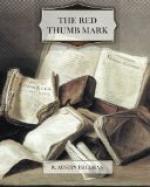“I observe, Thorndyke,” I now ventured to remark, “that you always examine the outside of a letter before looking at the inside. I have seen other people do the same, and it has always appeared to me a singularly foolish proceeding. Why speculate over an unopened letter when a glance at the contents will tell you all there is to know?”
“You are perfectly right,” he answered, “if the object of the inspection is to discover who is the sender of the letter. But that is not my object. In my case the habit is one that has been deliberately cultivated—not in reference to letters only, but to everything that comes into my hands—the habit of allowing nothing to pass without a certain amount of conscious attention. The observant man is, in reality, the attentive man, and the so-called power of observation is simply the capacity for continuous attention. As a matter of fact, I have found in practice, that the habit is a useful one even in reference to letters; more than once I have gleaned a hint from the outside of a letter that has proved valuable when applied to the contents. Here, for instance, is a letter which has been opened after being fastened up—apparently by the aid of steam. The envelope is soiled and rubbed, and smells faintly of stale tobacco, and has evidently been carried in a pocket along with a well-used pipe. Why should it have been opened? On reading it I perceive that it should have reached me two days ago, and that the date has been skilfully altered from the thirteenth to the fifteenth. The inference is that my correspondent has a highly untrustworthy clerk.”
“But the correspondent may have carried the letter in his own pocket,” I objected.
“Hardly,” replied Thorndyke. “He would not have troubled to steam his own letter open and close it again; he would have cut the envelope and addressed a fresh one. This the clerk could not do, because the letter was confidential and was addressed in the principal’s handwriting. And the principal would have almost certainly added a postscript; and, moreover, he does not smoke. This, however, is all very obvious; but here is something rather more subtle which I have put aside for more detailed examination. What do you make of it?”
He handed me a small parcel to which was attached by string a typewritten address label, the back of which bore the printed inscription, “James Bartlett and Sons, Cigar Manufacturers, London and Havana.”
“I am afraid,” said I, after turning the little packet over and examining every part of it minutely, “that this is rather too subtle for me. The only thing that I observe is that the typewriter has bungled the address considerably. Otherwise this seems to me a very ordinary packet indeed.”
“Well, you have observed one point of interest, at any rate,” said Thorndyke, taking the packet from me. “But let us examine the thing systematically and note down what we see. In the first place, you will notice that the label is an ordinary luggage label such as you may buy at any stationer’s, with its own string attached. Now, manufacturers commonly use a different and more substantial pattern, which is attached by the string of the parcel. But that is a small matter. What is much more striking is the address on the label. It is typewritten and, as you say, typed very badly. Do you know anything about typewriters?”




